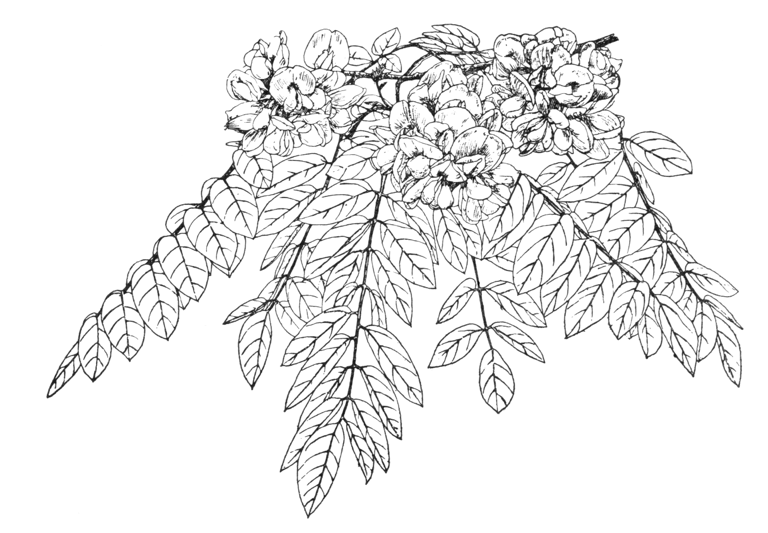A deciduous tree 30 to 40 ft high, with a trunk 12 to 18 in. thick, and often furnished with large burrs; young branches covered with glands which exude a sticky substance that adheres to the fingers when touched. Leaves pinnate, 3 to 10 in. long, the main-stalk hairy and viscid like the young twigs. Leaflets eleven to twenty-one, oval or ovate, 1 to 2 in. long, 1⁄3 to 3⁄4 in. wide, dark green above, paler and at first slightly downy beneath, ultimately glabrous. Stipules at first 1⁄4 in. long, becoming longer and spiny with age. Racemes 2 to 21⁄2 in. long, almost as wide, with a naked stalk half as long. Flowers 3⁄4 in. long, ten to fifteen in a raceme, without fragrance; petals pale rose with a yellow blotch on the standard; calyx dark red, hairy. Pod 2 to 31⁄2 in. long, covered with viscid glands. Bot. Mag., t. 560.
Native of the mountains of North Carolina, where it was originally discovered by William Bartram in 1776. It was introduced to France by Michaux in 1791, and six years later to England. It is a smaller tree than R. pseudacacia and of more stunted growth, but it flowers very freely and makes a bright picture towards the end of June. The viscid substance on the branches renders it easily distinguishable, although this appears to vary in amount, and is some times not very discernible. According to Sargent it is one of the rarest of American trees, and from the time of Michaux to 1882 was never found in a genuinely wild state. But it is now naturalised in many parts of the eastern United States. It is not common in English gardens, but there were several old trees at Kew, the largest of which had a trunk 5 ft 3 in. in girth at 5 ft from the ground, which is considerably more than the dimensions recorded of wild specimens. These old trees were almost unarmed, the spines only occurring on exceptionally vigorous shoots. A handsome tree in bloom.
The largest of the few trees recorded recently grows at Borde Hill, Sussex, and measures 42 × 4 ft (1968).
R. × ambigua Poir. R. dubia Foucault, not Poir.; R. intermedia Soulange-Bodin – A small group of hybrids between R. viscosa and R. pseudacacia, showing the influence of the former in their moderate size, viscid young growths and pink flowers, and of the latter in the usually better developed spines. The type arose in France a few years before 1812 and was at one time cultivated under the name R. dubia, but seems to have become rare. The following members of the group are still available:
cv. ‘Bella-rosea’. – Branchlets viscid, spiny. Flowers deep rosy pink. It is said to have arisen in Holland around 1860.
cv. ‘Decaisneana’. – This is retained by Rehder as a variant of R. pseudacacia but is now considered by most authorities to be a form of R. × ambigua. The branchlets are only very slightly viscid, but the influence of R. viscosa shows in the pink flowers and the reduced size of the stipular spines. It arose in Villevielle’s nursery at Manosque in the department of Basse-Alpes, and was described in 1863. It is said to come more or less true from seed, and no doubt some of its seedlings, deeper in colour than the original, have been propagated; this would explain why there is some variation in colour in ‘Decaisneana’, despite the fact that it is normally propagated by grafting.
‘Decaisneana’ is perhaps the most handsome of the arborescent robinias, but it needs more than average summer heat if it is to grow and flower well. In cool gardens it flowers sparsely, and is unsuitable for exposed positions, owing to the brittleness of the wood.


